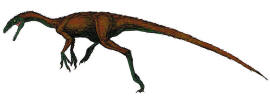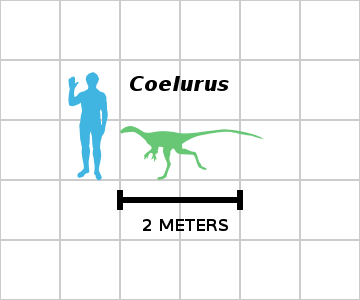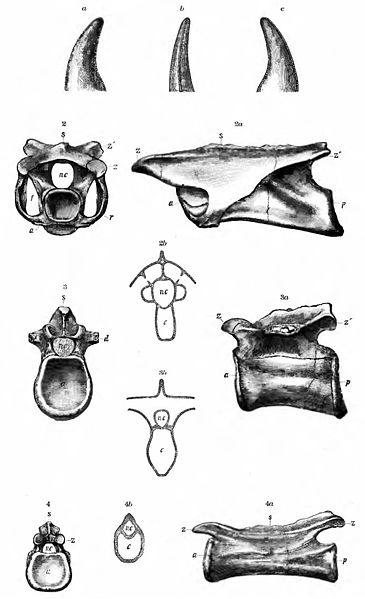the rest of the
known Coelurus
material. Although it has the same preservation and coloring as the
fossils known to belong
to the Coelurus
skeleton, it is very slender, which may mean it doesn't belong to the
skeleton; this bone is 7.9 centimeters long (3.1 in) but only
1.1 centimeters tall (0.43 in). In general, its vertebrae were long and
low, with low
neural spines and thin
walls to the
bodies of the
vertebrae. Its neck vertebrae were very pneumatic, with numerous hollow
spaces on their surfaces (pleurocoels); these hollows were not evenly
distributed among the vertebrae and varied in size. The neck vertebrae were
very elongate, with bodies four times longer than wide, and they articulated
with concave faces on both ends (amphicoely). The back vertebrae were not as
elongate, lacked surface hollows, and had less developed concave faces and
bodies that were
hourglass-shaped. The
tail vertebrae also lacked surface hollows.
The only bone known from the
shoulder girdle is a fragment of
scapula. The
upper arm had a
distinct S-shaped curve in side view and was slightly longer than the
forearm
(11.9 centimeters [4.7 in] versus 9.6 centimeters [3.8 in]). The wrist had a
semilunate
carpal similar to that
of
Deinonychus, and the
fingers were long and slender. The only bone known from the pelvic girdle is
paired and fused
pubis bones, which had
a prominent, long "foot" at the end. The
thigh bones had an
S-shape when viewed from the front. The
metatarsals were
unusually long and slender, nearly the length of the thigh bones (the best
preserved thigh bone is about 21 centimeters long [8.3 in]).
Coelurus, Ornitholestes, and Tanycolagreus
The three best-known small theropods
of the Morrison Formation — Coelurus,
Ornitholestes, and
Tanycolagreus — were
generalized coelurosaurs, and they have been mistaken for each other at
various times. Now that Coelurus
and Ornitholestes
have been more fully described, it is possible to distinguish them by
various characteristics of their anatomy. For example, they had visibly
different proportions: Coelurus
had a longer back and neck than Ornitholestes,
and longer, more slender legs and feet.
Coelurus and
Tanycolagreus are more similar, but differ in a
variety of details. Such details include the shape of the upper arm,
forearm, and thigh bones; the location of muscle attachments on the thigh
bone, proportionally longer back vertebrae; and, again, the very long
metatarsus of Coelurus.
Classification
Since the growth of
phylogenetic studies in
the 1980s, Coelurus
has usually been found to be a
coelurosaurian of
uncertain affinities, not fitting with the better-known
clades of the
Cretaceous. It, along with several other generalized coelurosaurians such as
the
compsognathids,
Ornitholestes, and
Proceratosaurus, has
had multiple placements around the base of Coelurosauria. However, a work
published by Phil Senter in 2007 following the description of
Tanycolagreus found it
and Coelurus to be
closely related at the base of
Tyrannosauroidea.
Coelurus is
sometimes put into its own family,
Coeluridae, although
the membership of the family has not been stable. Oliver Rauhut (2003)
proposed a Coeluridae composed of Coelurus
plus the compsognathids, but he and others have not since found the
compsognathids to group with Coelurus.
Phil Senter proposed that Coelurus
and Tanycolagreus
were the only coelurids and were actually
tyrannosauroids.
Before the use of phylogenetic
analyses, Coeluridae and Coelurosauria were
taxonomic wastebaskets
used for small theropods that didn't belong to other groups; thus, they
accumulated many
dubious genera. As late
as the 1980s, popular books recognized over a dozen "coelurids", including
such disparate forms as the
noasaurid
Laevisuchus and the
oviraptorosaurian
Microvenator, and
considered them descendants of the
coelophysids. A
wastebasket Coeluridae lingered into the early 1990s in some sources, but
since then it has only been recognized in a much reduced form.
History
Coelurus
was described in 1879 by Othniel Charles Marsh, an American paleontologist
and naturalist known for his "Bone
Wars" with
Edward Drinker Cope. At
the time, he only described what he interpreted as vertebrae from the back
and tail, found at the same location as the
type specimen of his
new genus and species Camptonotus dispar
(later renamed
Camptosaurus because
Camptonotus was
already in use). Marsh was impressed with the hollow interiors of the
thin-walled vertebrae, a characteristic that gave the
type species its name:
Coelurus fragilis.
He thought of his new genus as an "animal about as large as a wolf, and probably
carnivorous".
Coelurus
would prove to be the first named small theropod from the Morrison
Formation, although at the time Marsh was not certain that it was a
dinosaur. He returned to it in 1881 and provided illustrations of some
bones, along with putting it in a new
order (Coeluria) and
family (Coeluridae).
From here, the story becomes more
complex. Apparently, the skeleton was scattered throughout the quarry, with
the remains being recovered from September 1879 to September 1880. Marsh
elected to place some of the material in a new species,
C. agilis, on the strength
of a pair of fused pubic bones he thought belonged to an animal three times
the size of C. fragilis.
He returned to the genus in 1888 to add C.
gracilis, based on unknown remains only
represented today by a single
claw bone pertaining to
a small theropod from the
Early Cretaceous
Arundel Formation of
Maryland.
Interestingly, despite their professional animosity, Cope also assigned
species to Coelurus;
in 1887, he named fossils from the
Late Triassic of
New Mexico as
C. bauri and
C. longicollis. He would
later give them their own genus,
Coelophysis.
In 1903,
Henry Fairfield Osborn
named a second genus of small theropod from the Morrison Formation,
Ornitholestes. This
genus was based on a partial skeleton from Bone Cabin Quarry, north of Como
Bluff. Ornitholestes
became intertwined with Coelurus
in 1920, when
Charles Gilmore, in his
influential study of theropod dinosaurs, concluded that the two were
synonyms. This was
followed in the literature for decades. The two genera were not formally
compared, however, nor was there a full accounting of what actually belonged
to Coelurus, until
John Ostrom's study in
1980.
Gilmore had suspected that
C. fragilis and
C. agilis were the same,
but Ostrom was able to demonstrate this synonymy. This greatly expanded the
known material pertaining to C. fragilis,
and Ostrom was able to demonstrate that
Ornitholestes was quite different from
Coelurus. At the time,
Dale Russell had
proposed that C. agilis
was a species of
Elaphrosaurus based on
the incomplete information then published; Ostrom was also able to
demonstrate that this was not the case. Additionally, he showed that one of
the three vertebrae Marsh had illustrated for
C. fragilis was actually a composite of two
vertebrae, one of which was later shown to come from another quarry and
belonged not to Coelurus
but to another, unnamed small theropod. This unnamed genus would not be the
last small theropod from the Morrison Formation to be confused with
Coelurus; a later
discovery (1995) of a partial skeleton in Wyoming was first thought to be a
new larger specimen of Coelurus,
but further study showed it belonged to a different but related genus,
Tanycolagreus.
Paleobiology and Paleoecology
The
Morrison Formation is
interpreted as a semiarid environment
with distinct wet and dry seasons, and flat
floodplains. Vegetation
varied from river-lining forests of conifers, tree ferns, and ferns, to fern
savannas with rare
trees. It has been a rich fossil hunting ground, holding fossils of green algae, fungi, mosses,
horsetails, ferns,
cycads,
ginkgoes, and several
families of
conifers, as well as numerous dinosaur fossils.
Coelurus
is regarded as a small terrestrial carnivore, feeding on small prey items
like insects, mammals, and lizards. It is thought
to have been a fast animal, certainly faster than the similar but
shorter-footed Ornitholestes.
Return to the
Old Earth Ministries Online Dinosaur
Curriculum homepage.

Shopping


